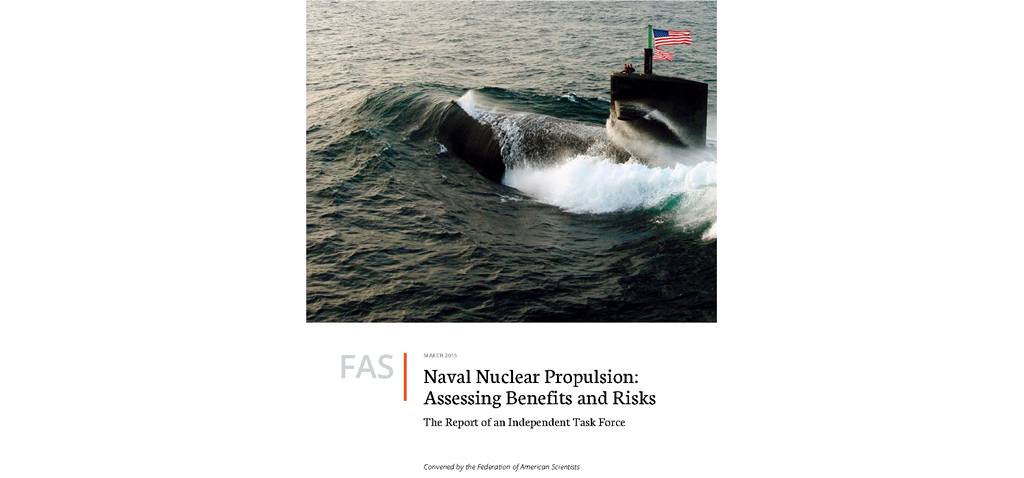
Naval Nuclear Propulsion: Assessing Benefits and Risks
The United States and other countries with nuclear navies have benefited from having nuclear-powered warships. But do the continued benefits depend on indefinite use of highly enriched uranium (HEU)—which can be made into nuclear weapons—as naval nuclear fuel? With budgetary constraints bearing down on the U.S. Department of Defense, the Naval Nuclear Propulsion Program is finding it difficult to address many competing needs including upgrading aging training facilities, handling spent nuclear fuel, and designing the next generation submarines to replace the Virginia-class attack submarines.
FAS convened an independent, nonpartisan task force of experts from the national security, nuclear engineering, nonproliferation and nuclear security fields to examine effective ways to monitor and safeguard HEU and LEU in the naval sector, and consider alternatives to HEU for naval propulsion so as to improve nuclear security and nonproliferation.
The results of the year-long task force study are compiled in the report, Naval Nuclear Propulsion: Assessing Benefits and Risks. The task force concluded that the U.S. Navy has strong incentives to maintain the continuing use of highly enriched uranium and would be reluctant, or even opposed, to shift to use of low enriched uranium unless the naval nuclear enterprise is fully funded and the Naval Nuclear Propulsion Program has adequate financial resources to try to develop a life-of-ship reactor fueled with LEU that would meet the Navy’s performance requirements. The task force endorses having the Obama administration and Congress allocate adequate funding for R&D on advanced LEU fuels no later than 2017 in time for development of the next generation nuclear attack submarine. “The United States should demonstrate leadership in working urgently to reduce the use in naval fuels of highly enriched uranium–that can power nuclear weapons–while addressing the national security needs of the nuclear navy to ensure that the navy can meet its performance requirements with lifetime reactors fueled with low enriched uranium,” said Dr. Charles D. Ferguson, Chair of the Independent Task Force and President of FAS.
Four companion papers written by task force members are also available:
- Investigation into the Unintended Consequences of Converting the U.S. Nuclear Naval Fleet from Highly Enriched Uranium (HEU) to Low Enriched Uranium (LEU) by Dr. Alireza Haghighat, Professor, Virginia Tech Transport Theory Group (VT3G), Nuclear Science and Engineering Laboratory (NSEL) Nuclear Engineering Program, Jack Bell, Graduate Research Assistant and Nathan Roskoff, Graduate Research Assistant.
- Phasing Out Highly Enriched Uranium Fuel in Naval Propulsion: Why It’s Necessary, and How to Achieve It by Dr. Alan J. Kuperman, Coordinator, Nuclear Proliferation Prevention Project and Associate Professor , LBJ School of Public Affairs, University of Texas at Austin.
- The UK Naval Nuclear Propulsion Programme and Highly Enriched Uranium by Dr. Nick Ritchie, University of York, UK.
- A Novel Framework for Safeguarding Naval Nuclear Material by Naomi Egel, Dr. Bethany L. Goldblum, & Erika Suzuki, University of California, Berkeley.
Naval Nuclear Propulsion: Assessing Benefits and Risks can be read and downloaded here (PDF).
The task force members thank the John D. and Catherine T. MacArthur Foundation for its generous support of this project.
A military depot in central Belarus has recently been upgraded with additional security perimeters and an access point that indicate it could be intended for housing Russian nuclear warheads for Belarus’ Russia-supplied Iskander missile launchers.
The Indian government announced yesterday that it had conducted the first flight test of its Agni-5 ballistic missile “with Multiple Independently Targetable Re-Entry Vehicle (MIRV) technology.
While many are rightly concerned about Russia’s development of new nuclear-capable systems, fears of substantial nuclear increase may be overblown.
Despite modernization of Russian nuclear forces and warnings about an increase of especially shorter-range non-strategic warheads, we do not yet see such an increase as far as open sources indicate.